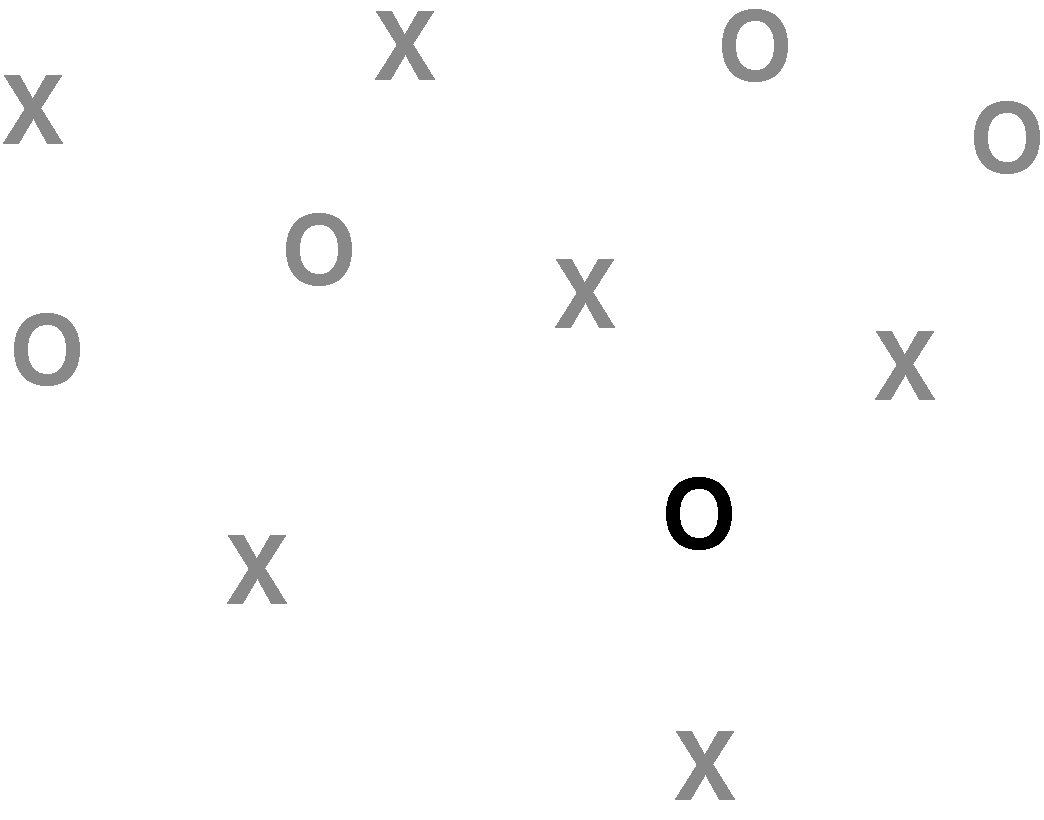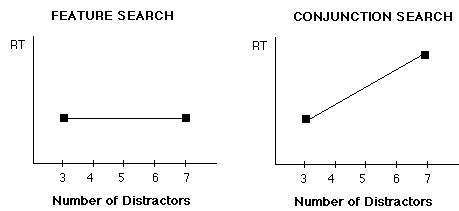
<<Back to Cognition Class Home Page
---------------------------------------------------------------------------------------
Wednesday, April 15Visual Search
Visual Pathways and Visual AGNOSIA
------------------------------------
VISUAL SEARCH and FEATURE INTEGRATION THEORY
How do we perceive objects? According to Anne Treisman, there are two ways to scan the environment for visual information: In parallel and serially. We can demonstrate the existence of these two different search strategies using the visual search paradigm.
INSTRUCTIONS: Look for a black "O" in the following display.

In this case, the search is very easy, and the black O seems to "pop out" without apparent effort.

In this case, the search task is more difficult, and one has the impression that a close examination of each item is necessary.
This subjective impression can be made more rigorous looking at the reaction times pattern in these two tasks.

Anne Treisman called the first, simpler task, FEATURE SEARCH. In this task, we can just look for a simple physical characteristic of the stimulus (black) in order to detect the target stimulus.
The second, more complex task, is called CONJUNCTION SEARCH. In this case, we have to look for a combination (conjunction) of two simple features: color and shape.
According to Anne Treisman, the feature search can be performed in parallel, and this parallel search corresponds to our impression of the target "popping out" in the display. In the parallel search, all the items are searched simultaneously, and therefore there is not effect of the number of distractors: reaction times are the about the same when the number of distractor increases.
The conjunction search requires a more effortful serial search. In this case, according to Treisman, one needs to focus attention on each item in order to "glue" the two features together. The serial search corresponds to our impression of "more difficult search" and is associated to an increase in reaction times as a function of the number of distractors: if we have to look at each item individually, the search will take longer when there are more items to search.
What does it happen if attention cannot focus on an object (for example in case of very rapid presentation)? Sometimes one can combine a shape with another color present in the display but not "belonging" to the same object. This phenomenon is called ILLUSORY CONJUNCTION.
These data have been replicated many times, so scientists believe them.
However, some researchers do not agree with Treisman interpretation of her data
and in the last years further evidence has been collected that suggests a more
complex situation.
First, it has been shown that, in a conjunction search situation, people can exclude part of the items that do not have a certain feature (in our display, exclude all the gray items), and then serially search the other items (discriminating Xs and Os among black items). This strategy is called GUIDED SEARCH.
Second, other researchers (for example Duncan and Humphreys) have proposed that other principles can explain the difference serial and parallel search in these two situations. In the feature search example above, all the distractor items are gray. According to the Gestalt principle of similarity, it is possible to consider the gray distractor as a unified field that can behave like a "background" for the target object. In the conjunction search this is not possible, because even if we can perceive the gray items as background, still we need to search the black items for the "O" target.
-------------------------------------------
VISUAL PATHWAYS AND VISUAL AGNOSIA
Our perceptual world is made of objects in space. However, one amazing thing about our visual system is that different features of objects and space are analyzed separately. For example, data from animal study, lesion and neuroimaging research suggest that there are regions of our brain that analyze color, other regions that analyze motion, other that analyze spatial coordinate. This is one empirical base for Treisman's Feature integration theory (our visual systems analyze visual scenes in terms of independent features-such color, motion, shape, and so on- that need to be put together to form an object. According to Treisman, attention is necessary to put together different features).
Evidence from animal studies and human lesion studies, and more recently from neuroimaging data using PET and fMRI strongly suggest that our visual system is organized in two separate pathways: the dorsal pathway and the ventral pathway.
The dorsal pathway, that goes from the occipital lobe (visual cortex) to the parietal lobe, analyzes spatial information associated to visual scenes. For example, where an object is, how to reach it, but also other feature of the object important for moving and be oriented in the world. This visual pathway is also called "WHERE" pathway.
The ventral pathway, that goes from the visual cortex to the temporal lobe, analyzes features important for object recognition and is called "WHAT" pathway.
Lesions to one of these two pathways impair visual perception in different ways. For example, a lesion that damages the "what" pathway will result in difficulty in recognizing objects in absence of pure visual impairment (the patient can "see" but cannot tell which object is, what its name is, what its function is). However, other visual information such as position, will be preserved. The patient will also be able to recognize an object presented in other modalities (for example if he can touch it he will be able to recognize the object).
---------------------------------------------------------------------------------------